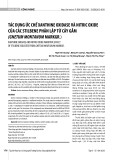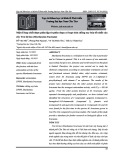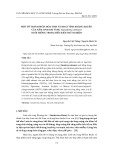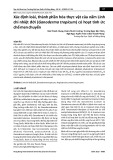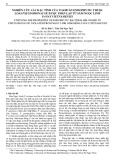
TNU Journal of Science and Technology
230(01): 32 - 39
http://jst.tnu.edu.vn 32 Email: jst@tnu.edu.vn
SURVEYING THE ORIGIN AND BIOLOGICAL CHARACTERISTICS OF
STEPHANIA BRACHYANDRA (DIELS) GENE SOURCES IN THAI NGUYEN
Duong Van Thao*
TNU - University of Agriculture and Forestry
ARTICLE INFO
ABSTRACT
Received:
19/6/2024
This study focuses on the biological characteristics of the genetic resources
of the Stephania brachyandra in Thai Nguyen, one of Vietnam's valuable
medicinal plants currently at risk of extinction. Investigation results indicate
that Stephania brachyandra is commonly found at an average density of
32.57 plants per square kilometer, with distribution density varying across
districts, being highest in Vo Nhai district and lowest in Phu Luong district.
This species primarily thrives in rocky mountain forests and regenerating
land after extension exploitation. The plant is predominantly found above
attitudes 250 m, followed by altitudes between 200-250 m, and is least
common at altitudes below 200 m. The average shrub cover density in the
Open Top Chambers (OTCs) with Stephania brachyandra populations
surveyed across the districts is 18%, significantly lower compared to other
plant species such as: Mua, Sim, Don nem, and Tu chau. The average ground
cover density is 15.8%, mainly consisting of weeds such as grass, daisies,
bamboo grass, pig bristle grass, and betel leaf. Regarding soil, the thickness
of the A0 horizon varies from 1 to 4 cm. The A horizon has an average
thickness of 30.3 cm, and is reddish-brown, moist and friable, with low rock
content. The B horizon has an average thickness of 60 cm, and is yellow-
brown, moist, slightly compact, with higher rock content. The chemical
composition of the soil ranges from medium to nutrient-poor.
Revised:
16/10/2024
Published:
17/10/2024
KEYWORDS
Stephania brachyandra
Origin
Biological characteristics
Distribution
Gene sources
KHẢO SÁT NGUỒN GỐC, ĐẶC ĐIỂM SINH HỌC NGUỒN GEN
CÂY BÌNH VÔI NHỊ NGẮN TẠI THÁI NGUYÊN
Dương Văn Thảo
Trường Đại học Nông Lâm – ĐH Thái Nguyên
THÔNG TIN BÀI BÁO
TÓM TẮT
Ngày nhận bài:
19/6/2024
Nghiên cu ny tp trung vo cc đặc điểm sinh học nguồn gen cây bình
vôi nhị ngắn tại Thái Nguyên, mt trong s nhng loi cây thuc qu ca
Vit Nam v đang c nguy cơ tuyt chng. Qua kết quả điều tra cho thấy
Bình vôi thường được tìm thấy ở mt đ trung bình là 32,57 cây/1 km2, với
mt đ phân b dao đng qua các huyn, cao nhất là ở huyn Võ Nhai và
thấp nhất là ở huyn Phú Lương. Loi ny ch yếu sng ở các khu rừng núi
đ v đất đang ti sinh sau khi bị khai thác mạnh mẽ. Loài cây này ch yếu
tp trung ở đ cao > 250 m, tiếp đến là ở đ cao từ 200-250 m và ít phổ
biến nhất ở đ cao < 200 m. Tỷ l che ph ca cây bụi trung bình trong các
ô tiêu chuẩn (OTCs) có phân b ca loài Bình vôi nhị ngắn ở các huyn đã
được khảo sát là 18%, thấp hơn đng kể so với cc loi cây khc như Mua,
Sim, Đơn nem v Tu châu. Mt đ che ph trung bình ca lớp thảm tươi l
15,8%, ch yếu bao gồm cỏ dại như Cỏ, Cúc, Cỏ Tre, Cỏ Lông Lợn và Lá
Lt. Về đất đai, đ dày tầng A0 biến đng từ 1-4 cm, tầng A c đ dày trung
bình là 30,3 cm, mu nâu đỏ, ẩm và xp, c hm lượng đá thấp. Tầng B có
đ dày trung bình là 60 cm, màu nâu vàng, ẩm, hơi chặt, c hm lượng đ
cao hơn. Thnh phần hóa học ca đất biến đng từ trung bình đến nghèo chất
dinh dưỡng.
Ngày hoàn thiện:
16/10/2024
Ngày đăng:
17/10/2024
TỪ KHÓA
Bình vôi
Nguồn gc
Đặc điểm sinh học
Phân b
Nguồn gen
DOI: https://doi.org/10.34238/tnu-jst.10632
Email: duongvanthao@tuaf.edu.vn

TNU Journal of Science and Technology
230(01): 32 - 39
http://jst.tnu.edu.vn 33 Email: jst@tnu.edu.vn
1. Introduction
The term Stephania brachyandra (Diels) refers to a species of climbing plants with tuberous
roots belonging to the genus Stephania, family Menispermaceae [1]. Globally, the genus Stephania
comprises over 50 species, while in Vietnam, there are about 14 to 16 species widely distributed
across the northern, central, and southern regions, commonly found in limestone mountainous areas
such as Tuyen Quang, Hoa Binh, Cao Bang, Thai Nguyen, Thanh Hoa, Lam Dong, and Ba Ria –
Vung Tau [1].
The scientific name is Stephania brachyandra, belonging to the family Menispermaceae. It is a
climbing plant primarily distributed in China and Southeast Asian countries, including Vietnam.
The Stephania brachyandra tuber contains various alkaloids, among which the compound rotundin
(or L-tetrahydropalmatine) is present in large amounts [2], [3]. Traditionally, in ancient medicine,
the Stephania brachyandra was used for its medicinal properties. The tuber was used in decoctions
or alcohol infusions to treat insomnia, provide sedation, relieve headaches, and alleviate abdominal
pain. Currently, rotundin is mainly used to treat insomnia and provide sedation. Natural rotundin
has prominent advantages such as low toxicity, good drug tolerance, the ability to induce
physiological sleep, and helping to restore memory [4]-[9]. Rotundin is a pharmaceutical
compound extracted from the tuber of the Stephania brachyandra. According to healthcare
industry statistics, Vietnam imports about 30 tons of rotundin annually, valued at approximately
180 billion VND [10], [11].
Currently, the demand of rotundin from the Stephania brachyandra tuber is increasing in
Vietnam and worldwide. The Military Medical Academy has successfully researched the semi-
synthesis of rotundin into rotundin sulfate for the production of injectable drugs. Commercial
products containing rotundin and rotundin sulfate such as Brachyandra, Sen vong, Roxen, and
Nightqueen have become increasingly available in the market. However, the source of Stephania
brachyandra tubers in Vietnam is depleting due to unregulated and excessive exploitation.
Therefore, it is essential to survey and identify Stephania brachyandra species with high rotundin
content, then develop conservation and propagation plans for the Stephania brachyandra. The
study "Surveying the origin, biological characteristics, yield, and quality of the genetic resources
of the Stephania brachyandra" was conducted to preserve the genetic resources of the Stephania
brachyandra in Thai Nguyen province.
2. Materials and methods
2.1. Materials
Study on the origin and biological characteristics of the genetic resource of Stephania
brachyandra in Thai Nguyen.
2.2. Methods
2.2.1. Approach
Stephania brachyandra a rare plant, primarily within limestone mountains, hilly terrain, and
lowland areas of limestone ranges. Therefore, research and conservation efforts focus mainly on
natural forests. An interdisciplinary research approach is the most effective method, encompassing
botanical classification, non-timber forest product surveys, biotechnology, and medicinal plant
cultivation. From describing morphological characteristics to genetic traits and propagation and
cultivation techniques, all methods are applied to conserve this species [12].
2.2.2. Surveying genetic resources by ecological region, altitude, and forest condition
Step 1: Conduct research involving local residents, forest rangers, and commune forestry
officers to identify areas or locations where Stephania brachyandra is found.
Step 2: Perform field surveys using the transect survey method to determine the distribution

TNU Journal of Science and Technology
230(01): 32 - 39
http://jst.tnu.edu.vn 34 Email: jst@tnu.edu.vn
density by counting the number of Stephania brachyandra found along the total length and width
of the survey transects. Collect soil samples and measure the size and morphological characteristics
of the plants.
Step 3: Conduct a preliminary selection of mother plants for Rotundin analysis. Collect tuber
samples and transport them to the analysis site for Rotundin content determination, with a total of
160 samples collected.
2.2.3. Supplementary investigation of the biological characteristics of the Stephania brachyandra
Table 1. Summary of Survey Transects
District
Dinh Hoa
Phu Luong
Vo Nhai
Dai Tu
Dong Hy
No. of Transects
8
7
10
4
4
The methods for soil sampling, preservation, and analysis were carried out according to proper
standards. On each survey transect, five soil profiles were selected at locations where Stephania
brachyandra was distributed. Soil profiles were then excavated and key indicators described, such
as the average thickness of the soil layer, color, moisture, porosity, proportion of exposed rocks
and rock fragments, as well as mechanical composition. The soil samples were then transferred to
the Soil Analysis Laboratory of the Northern Mountainous Agriculture and Forestry Science
Institute for analysis. Simultaneously, the biological characteristics of the Stephania brachyandra
were also investigated, including the size of the stem and leaves, the structure and color of the
flowers and fruits [12].
2.3. Data Analysis
The data resulting from this study were analyzed using SPSS and Microsoft Excel software.
3. Results
3.1. Distribution of the Stephania brachyandra species according to forest condition
3.1.1. Distribution of Stephania brachyandra species by forest condition
Based on the data from Table 2 and Figure 1, it can be observed that the number of Stephania
brachyandra individuals across the survey transects is relatively low, averaging 32.57 plants per
square kilometer (with a transect width of 20 m and a length of 639 km). The distribution density
varies unevenly among districts, with the highest density in Vo Nhai district and the lowest in Phu
Luong district. Stephania brachyandra are predominantly inhabit in rocky mountain forests and
land mountain forests in recovering forest conditions, which have been heavily exploited. The
weight of Stephania brachyandra tubers ranges from 0.3 to 4.2 kilograms per tuber. From the
survey results, it can be concluded that Stephania brachyandra typically thrive in natural forest
environments and are not concentrated in clearings. The survey results indicates that Stephania
brachyandra are shade-tolerant species.
Table 2. The distribution density of Stephania brachyandra in Thai Nguyen province
District
No. of Survey
Transects
Total
Length
(km)
No. of
Plants
Observed
Density
(plants/km2)
Forest Condition
Dinh Hoa
8
143.9
73
25.36
Limestone mountains, IB, IC, IIA,
IIB, IIIA1
Dai Tu
4
100.8
79
39.18
IIA, IIB, IIIA1
Dong Hy
4
94.8
55
29.01
IIA, IIB, IIIA1, Limestone mountains
Phu Luong
7
134.2
61
22.73
IIA, IIB, IIIA1, Limestone
mountains
Vo Nhai
10
165.3
154
46.58
Limestone mountains, IIA, IIB, IIIA1,
IIIA2, IIIB
Total
33
639.0
422
32.57
-
Source: Compilation of survey data

TNU Journal of Science and Technology
230(01): 32 - 39
http://jst.tnu.edu.vn 35 Email: jst@tnu.edu.vn
Figure 1. Distribution density of Stephania brachyandra in Thai Nguyen province
The larger tubers are predominantly concentrated in the rocky mountain forests of Vo Nhai and
Dinh Hoa, where difficult terrain poses significant challenging. In recent years, the reason behind
is the extensive exploitation of Stephania brachyandra tubers to sell to middlemen who then supply
them to Rotudin production facilities. According to local residents, about 5-7 years ago, each
household would harvest 500 - 2000 kg of tubers annually from natural forests, with some tubers
weighing as much as 50 to 60 kilograms.
3.1.2. Distribution by ecological form
Based on the survey results, the study has classified the ecological types as follows: limestone
mountain forests, natural upland forests, and regenerated forests after shifting cultivation. The
research findings are summarized in Table 3.
Table 3. Distribution of Stephania brachyandra by ecological forms
No.
Ecological Form
Limestone Mountain Forests
Natural Upland Forests
Regenerated Forests
Quantity
Percentage (%)
Quantity
Percentage (%)
Quantity
Percentage (%)
1
184
43.60
236
55.93
2
0.47
(Source: Compilation of survey data)
The data from Table 3 indicates that the Stephania brachyandra species is primarily distributed
in limestone mountain forest and natural upland forest ecological forms. Although the percentage
of Stephania brachyandra detected in natural upland forests is higher than the percentage found in
limestone mountain forests it is noted that limestone mountain forests in Thai Nguyen account for
only about a quarter of the total natural forest area in the province.
3.1.3. Distribution by altitude
Table 4. Distribution of Stephania brachyandra by altitude
No.
Elevation levels (m)
< 200
200-250
> 250
Quantity
Percentage
(%)
Quantity
Percentage (%)
Quantity
Percentage
(%)
1
25
5.92
128
30.33
269
63.75
(Source: Compilation of survey data)
The aggregated data in Table 4 indicates that Stephania brachyandra is predominantly
distributed at altitudes above 250 m, followed by altitudes of 200-250 meters, and least at altitudes
below 200 meters. This phenomenon is due to the fact that in areas with lower altitudes,
accessibility is convenient, leading to extensive exploitation by local residents. Consequently, only
very small tubers weights, usually ranging from 0.2 to 0.4 kg, remain. As altitude increases, the
25.36
39.18
29.01
22.73
46.58
N/km2

TNU Journal of Science and Technology
230(01): 32 - 39
http://jst.tnu.edu.vn 36 Email: jst@tnu.edu.vn
search and exploitation become more challenging, resulting in a higher number of Stephanie
brachyandra remaining compared to lowland hilly areas.
3.1.4. Characteristics of shrubs and ground cover in areas where Stephania brachyandra is distributed
The survey data on regeneration, shrubs, and ground cover have been compiled in Table 5.
Table 5. Average coverage of shrubs and ground cover in areas where Stephania brachyandra is distributed
Description
Unit
Phu
Luong
Vo Nhai
Dinh Hoa
Dong Hy
Dai Tu
Average
Shrubs
%
25
20
13
10
22
18
Ground cover
%
30
14
13
15
7
15.8
(Source: Compilation of survey data)
The data in Table 5 indicates that the average coverage of shrubs in the Out-of-Trial Control
(OTC) areas where Stephania brachyandra is distributed across the surveyed districts is 18%. This
is a relatively low coverage level, primarily influenced by species such as Mua, Sim, Don nem, Tu
chau,… When evaluating for the richness of the shrub layer with such low coverage, the
regeneration and growth potential of naturally regenerating Stephania seedlings are impacted. The
average ground cover is 15.8%, with dominant species being weeds, grasses, bamboo grass, hairy
grass, and betel leaves. When evaluating the diversity of the climbing plant and ground cover layer
(Drude), this was also observed in the shrub layer. With such low coverage, it certainly affects the
regeneration capacity and quality of Stephania brachyandra regeneration.
3.2. Soil physical and chemical properties
The results of the soil chemical analysis in areas where Stephania brachyandra is distributed
have been compiled in Table 6. Based on the analysis parameters and assessment of the
composition and pH level, the following characteristics are observed. The total nitrogen content in
the soil ranges from 0.111% to 0.261%, with readily soluble nitrogen levels ranging from 3.997
mg/100 grams. The total phosphorus content in the soil varies from 0.021% to 0.088%, with readily
soluble phosphorus levels fluctuating between 5.820 and 39.930 mg/100 grams. The total
potassium content in the soil ranges from 0.082% to 0.524%, with readily soluble potassium levels
ranging from 1.266 to 6.991 mg/100 grams. The pH index (KCI) of the soil varies from 4.98 to
6.24, indicating a neutral pH soil. The organic matter content in the soil ranges from 1.43 to 3.89%,
which is an average indicator for plant growth and development. From these parameters, it can be
observed that the soil in areas where Stephania brachyandra is distributed varies from moderately
to poor in nutrient content. These characteristics may affect the growth and development of
Stephania brachyandra.
Table 6. Results of soil chemical analysis in areas where Stephania brachyandra is distributed
No.
Sample
code
Analysis indicators
pH(Kcl)
OM
(%)
Nts
(%)
Pts
(%)
Kts
(%)
Ndt
(mg/100g)
Pdt
(mg/100g)
Kdt
(mg/100g)
1
1
5.82
1.980
0.188
0.059
0.159
5.210
31.220
1.421
2
2
5.77
1.590
0.261
0.054
0.113
4.112
22.550
1.266
3
3
5.67
2.050
0.140
0.021
0.193
4.200
9.033
4.667
4
4
5.91
2.570
0.222
0.076
0.177
3.994
7.556
3.551
5
5
5.98
2.310
0.205
0.044
0.211
4.900
22.412
3.556
6
6
5.88
2.860
0.211
0.056
0.128
4.577
21.431
1.998
7
7
5.79
2.760
0.189
0.031
0.112
4.612
13.552
2.331
8
8
5.22
2.570
0.199
0.066
0.099
3.997
27.912
1.227
9
9
4.98
2.980
0.168
0.088
0.082
4.669
29.990
3.926
10
10
5.62
2.770
0.194
0.077
0.121
4.055
26.662
3.542
11
11
5.77
2.810
0.197
0.087
0.133
5.221
9.662
2.314


